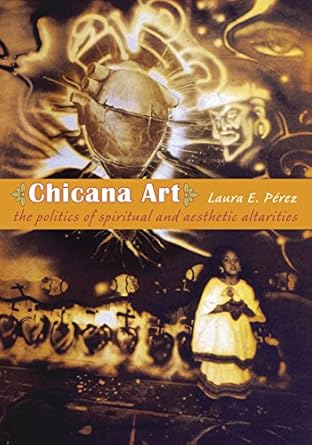Discover the vibrant world of Chicana art through “Chicana Art: The Politics of Spiritual and Aesthetic Altarities,” an essential read for anyone passionate about cultural expression and social justice. This pioneering, beautifully illustrated study by Laura E. Pérez delves into the dynamic works of over forty Chicana artists, showcasing their innovative approaches to painting, sculpture, performance, and more. With compelling pieces like Alma Lopez’s “Lupe & Sirena in Love” and Ester Hernandez’s “Libertad/Liberty,” this book highlights how these artists intertwine spirituality and activism to challenge societal norms and create a more inclusive art narrative.
Not only does this book serve as a vital archive, but it also offers a rich interpretive framework that celebrates the cultural hybridity and resilience of Chicana identity. By reimagining traditional iconography and exploring themes of race, gender, and sexuality, these artists invite readers to engage with an art form that transcends boundaries and speaks to the heart of contemporary issues. Don’t miss out on this transformative exploration of Chicana visual arts!
Chicana Art: The Politics of Spiritual and Aesthetic Altarities (Objects/Histories)
Why This Book Stands Out?
- Pioneering Focus: This is the first comprehensive study dedicated solely to Chicana visual arts, making it a groundbreaking resource for understanding this vibrant cultural movement.
- Diverse Artistic Mediums: The book explores a wide array of artistic expressions, including painting, printmaking, sculpture, performance, and even digital media, showcasing the richness of Chicana creativity.
- Invaluable Archive: Laura E. Pérez presents over forty Chicana artists’ works, creating a vital archive that documents and honors their contributions to contemporary art.
- Rich Interpretive Framework: The author provides insightful analyses that connect art with cultural identity, spirituality, and social justice, inviting readers to engage deeply with the themes presented.
- Culturally Hybrid Spirituality: The book highlights how Chicana artists challenge societal norms and rework traditional iconography, adding layers of meaning that resonate across cultures.
- Lavishly Illustrated: With stunning visuals accompanying the text, readers can fully appreciate the beauty and power of the artworks discussed, enhancing their overall experience.
- Timely and Relevant: Given the ongoing conversations around inclusivity and representation in the arts, this book is essential for anyone interested in broadening their understanding of American artistic traditions.
Personal Experience
As I delved into Chicana Art: The Politics of Spiritual and Aesthetic Altarities, I found myself reflecting on the profound connections between art, culture, and identity. Each page offered not just visual stimulation but a deep emotional resonance that spoke to my own experiences and struggles. It was as if the voices of the Chicana artists reached out to me, inviting me to explore the intersections of my own heritage and the universal themes of love, liberation, and resilience.
Throughout the book, I was particularly struck by the piece “Lupe & Sirena in Love” by Alma Lopez, which beautifully illustrated the embrace of two iconic figures. It made me think about the importance of representation in art; how powerful it is to see one’s identity and desires reflected in the narratives we consume. This notion of visibility, especially for marginalized communities, deeply resonated with me, reminding me of the significance of sharing our stories.
The work of Ester Hernandez challenged me to reconsider familiar symbols, like the Statue of Liberty. The idea of reimagining iconic figures to reflect diverse backgrounds and histories sparked a sense of empowerment within me. It was a reminder that we, too, can redefine narratives and claim our spaces in a world that often tries to silence us.
Moreover, Irene Perez’s portrayal of the Aztec warrior goddess made me reflect on the strength found in reclaiming our histories. It felt like an invitation to honor the legacies of those who came before us, acknowledging their struggles and triumphs as part of our own journey. I found myself pondering how art can serve as a form of resistance, a way to challenge societal norms and create new pathways for understanding.
Here are a few key insights from my experience with the book:
- The power of representation in art can validate personal identities.
- Reimagining familiar symbols allows for the creation of inclusive narratives.
- Art can be a form of resistance, challenging societal norms and advocating for change.
- Exploring the work of diverse artists can deepen our understanding of cultural histories and identities.
Engaging with this book felt like embarking on a journey—one that encouraged me to examine my own beliefs and to appreciate the rich tapestry of experiences that shape us all. I invite you to explore this beautiful work, as it may resonate with your own experiences and inspire you in ways you least expect.
Who Should Read This Book?
If you’re someone who loves art, culture, and the rich tapestry of identity, then “Chicana Art: The Politics of Spiritual and Aesthetic Altarities” is a must-read for you! This book opens a window into the vibrant world of Chicana artists, and it’s perfect for a variety of readers:
- Students and Scholars of Art History: If you’re studying art, especially with a focus on underrepresented voices, this book will provide you with a wealth of knowledge about Chicana visual arts and their cultural significance.
- Cultural Enthusiasts: Those interested in the intersections of culture, spirituality, and identity will find this book to be an invaluable resource that highlights the unique contributions of Chicana artists to American art.
- Artists and Creatives: If you’re an artist yourself, this book will inspire you with its exploration of innovative techniques and themes used by Chicana artists, encouraging you to think outside the box in your own work.
- Activists and Advocates: Readers passionate about social justice issues will appreciate how the artists in this book challenge racism, patriarchy, and homophobia through their powerful visual narratives.
- General Readers with an Interest in Diversity: If you enjoy learning about different cultures and perspectives, this book will broaden your understanding of Chicana art and the rich histories behind it.
By reading this book, you’ll not only gain insight into the artistic expressions of Chicana women but also appreciate the broader implications of their work in challenging societal norms and creating space for diverse narratives. It’s a celebration of creativity that’s sure to resonate with anyone who values inclusivity in the arts!
Chicana Art: The Politics of Spiritual and Aesthetic Altarities (Objects/Histories)
Key Takeaways
This book, “Chicana Art: The Politics of Spiritual and Aesthetic Altarities,” offers a rich exploration of Chicana visual arts, highlighting the unique contributions of over forty artists. Here are some of the most important insights and benefits readers can expect:
- Diverse Artistic Representations: The book showcases a wide range of artistic media, including painting, printmaking, photography, and performance, allowing readers to appreciate the versatility of Chicana artists.
- Cultural Hybridization: Readers will learn about how Chicana artists blend pre-Columbian and contemporary influences to create culturally hybrid expressions that challenge traditional narratives.
- Intersectionality: The work explores themes of racism, patriarchy, bigotry, and homophobia, demonstrating how Chicana artists engage with and critique these societal issues through their art.
- Spirituality in Art: The book delves into how Chicana artists invoke spiritual elements from both indigenous and non-Western traditions, enriching the understanding of spirituality in their works.
- Historical Context: It provides a critical framework for understanding the evolution of Chicana art from the 1960s to the early 2000s, making it a valuable resource for those interested in art history.
- Inclusive Canon: By focusing on Chicana artists, the book contributes to a more inclusive narrative within American art history, inviting recognition and appreciation of diverse voices.
Final Thoughts
Chicana Art: The Politics of Spiritual and Aesthetic Altarities is a groundbreaking exploration into the vibrant and diverse world of Chicana visual arts. Through the lens of over forty talented artists, Laura E. Pérez crafts a compelling narrative that showcases how these creators challenge societal norms and celebrate their cultural heritage. This beautifully illustrated book not only serves as an invaluable archive of artistic expression but also as a powerful commentary on issues of identity, spirituality, and resistance.
With a rich interpretive framework, Pérez invites readers to engage with the dynamic works produced between 1985 and 2001, revealing how Chicana artists have redefined traditional iconography and integrated elements of pre-Columbian and non-Western cultures into their creations. The discussions surrounding key pieces, such as Esther Hernandez’s Libertad/Liberty and Alma Lopez’s Lupe & Sirena in Love, highlight the significant impact these works have on both the art world and the broader conversation about inclusivity.
- Explore the work of over forty Chicana artists across various media.
- Gain insight into the intersection of art, spirituality, and cultural identity.
- Understand the historical context and evolution of Chicana visual arts.
- Appreciate the unique ways these artists challenge societal norms and represent marginalized voices.
This book is a must-have for anyone interested in art, culture, or social justice. It not only enriches your understanding of Chicana art but also inspires a deeper appreciation for the diverse narratives that shape our world. Don’t miss the opportunity to add this significant work to your collection. Purchase Chicana Art: The Politics of Spiritual and Aesthetic Altarities today!





